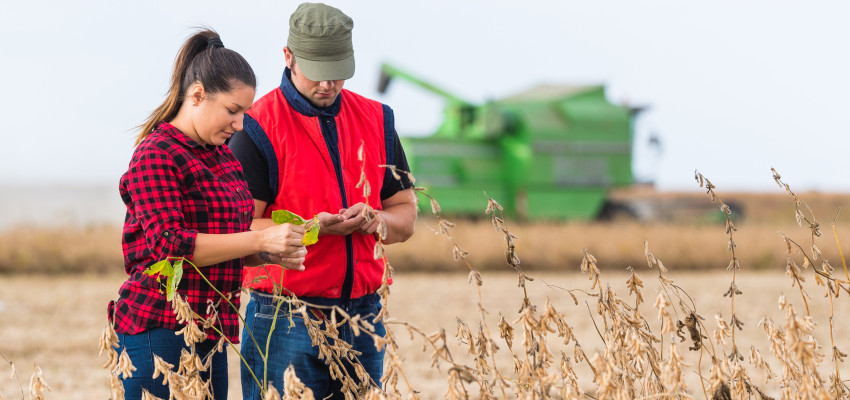By Dixie Vogel on January 30, 2018
The Science of GMOs
Learn the science behind GMOs (for non-scientists)

I have a history of avoiding GMO conversations. It’s not the topic itself that bothers me. I dig science, and GMOs are straight-up science, applied in a way that impacts nearly everyone on the planet.
It’s the emotional intensity of so many GMO discussions that put me off. Not understanding enough to discuss it intelligently, I saw zero point in subjecting myself to the drama. Unlike most farmers, I’ve largely had the option of avoiding potentially contentious GMO debate.
But avoiding GMO conversations didn’t mean I wasn’t hearing about GMOs.
In my quest to become my own food guru, I read a lot about healthy eating. GMOs are frequently mentioned, but generally in an off-hand way, as if it’s just common knowledge we shouldn’t be eating them. Even writers who routinely offer scientific justification for recommendations simply don’t, when advising against GMOs. It’s as if the technology is the objection, not the final product.
I’ve also heard folks in agriculture discuss GMOs with those outside the agricultural community. There’s a note of weariness and wariness in those voices, as if fear and criticism surrounding the topic has worn them down. They came across to me as practical, down-to-Earth people who felt misunderstood and vilified over their decision to work with GMOs.
It’s easy to get the impression almost everyone is worried about eating GMOs. An informal survey of my friends surprised me, though: none were especially concerned. It’s just the people who are the most bothered tend to be the loudest. The volume creates enough social pressure so those who aren’t as emotionally invested tend to keep their mouths shut. That’s exactly what I’ve always done.
So, with social pressure, and the proliferation of “GMO-Free” labels demonstrating market pressure, I wondered what it is that keeps GMOs alive and kicking. The fact farmers continue to utilize GMOs suggests there must be compelling reasons to buck the tide.
Fortunately, I got the opportunity to cut through some of the haze. I could not have asked for a better introduction to the world of GMOs than quizzing a couple of researchers directly involved in tackling real-world problems via bioengineering.
Dr. Harold Trick of Kansas State University and Dr. Tom Clemente of the University of Nebraska each generously agreed to answer whatever GMO questions I could think up to ask. The fact I got to hang out with outrageously smart people who obviously care about the work they’re doing was just a delightful bonus.
What is a GMO, anyway?
GMO stands for “Genetically Modified Organism.” But genetically engineered would be a more precise description. Both evolution and historic farming practices like selective breeding and hybridization have been genetically modifying food for millennia.
What we commonly refer to as “GMO,” though, are plants (or less commonly, animals), molecularly altered via bioengineering.
Differences between GMO and traditional plant breeding
Genetic engineering differs from traditional plant breeding in methods as well as potential, but the overall idea is roughly the same. Since proteins control what traits are expressed in living organisms, all plant breeding seeks to alter the proteins a plant produces.
Plants are made up of cells. Within the nucleus of each cell are chromosomes. A gene is a portion of a chromosome, comprised of what we call DNA. DNA creates what’s known as RNA, the portion of a gene carrying a “recipe” on how to create a specific protein outside the cell, to the rest of the plant.
In traditional plant breeding, large amounts of DNA are transferred to a highly similar plant, in hopes a desired trait will get transferred. Features like drought tolerance, pest resistance or better taste could be among desirable traits.
It normally takes multiple plant generations of old fashioned trial-and-error to get a win with traditional breeding. Because the source and target plants must be very closely related to transfer DNA this way, there’s an extremely limited number of traits to access. It’s roughly as precise as throwing a big handful of spaghetti at the wall, hoping the specific strand you want to use sticks.
Genetic engineering is far more predictable. Researchers isolate a specific section of a specific strand of DNA, identified as containing the desired trait. Because DNA is universal, researchers can use DNA from completely unrelated plants or even animals to isolate a trait.
Scientists use a sequence of genetic material known as the “Plant Expression Cassette” to make this possible – there’s a promoter (turning on the process), a gene (carrying instructions for making the target protein), and a terminator (turning off the process). So, it’s essentially a package of genetic material with a built-in on/off switch.
Much GMO work is done using Aggrobaterium, a plant disease that easily replicates. While the thought of intentionally infecting a plant with disease may sound off-putting, geneticists completely remove the disease and replace it with desired genetic payload, co-opting the bacteria into becoming a robust delivery system.
Or researchers may use a “gene gun,” firing gold particles coated with genetic material directly into plant cells using a blast of helium. There are other techniques too, but the result is the same: scientists can do much more with genetic engineering, much more successfully, than ever before in the history of farming.
But do we really need all these GMOs?
Those outside of agriculture could be forgiven for wondering, “Why bother with GMOs?” But there are many goals for GMO development beyond making more, bigger or prettier fruits and vegetables.
Increasing genetic diversity is one of the most vital goals of GMO work. Introducing traits from dissimilar sources allows farmers to grow food that can withstand shifting climate, address varying nutritional needs of different populations, or overcome threats of pests or disease. Genetic diversity is essentially insurance against adverse events that would otherwise threaten our food supply.
Research from GMOs is also extremely helpful in understanding gene function. This allows scientists to better understand diseases and develop affordable medications. Almost all insulin on the market today is GMO-derived. Many vaccines and medicines are produced using GMOs or GMO technology.
Environmental benefits of GMO crops include the ability to use no-till farming—a practice that preserves nutrient-rich topsoil, requiring less water and fuel and reducing soil erosion. GMO crops also allow farmers to use dramatically fewer herbicides — in 2003, it was 43 million pounds fewer per year.
What I consider the most pressing application of GMOs is one I’m blessed enough to often forget: people still starve. More than one billion people live in places where food needs exceed the capacity of the land. Nutritional deficiencies create preventable disease, suffering and death. Genetic engineering helps farmers satisfy the specific and changing needs of different populations.
Considering all this, it’s not hard to understand why GMO work continues, despite pressures against it. But stay tuned, because there’s more to the story.
Next time, we’ll be looking at the most common concerns surrounding GMOs.
Sources
Dr. Thomas Clemente, Center for Plant Science Innovation. Personal interview, December 5, 2017.
Dr. Harold Trick, Department of Plant Pathology. Personal interview, November 20, 2017.
Dr. Harold Trick, Kansas State University Research & Extension Presentation. “The Science of GMOs: What you need to know to make an informed assessment.” May 17, 2017. Accessed online, January 16, 2018. https://www.dropbox.com/s/r7v26kh78tjonfj/EMFV%20Manhattan%20May%202017.ppt?dl=0
Friedman, David H. Scientific American. “The Truth About GMO Food,” September 1, 2013. Accessed online, January 16, 2018. https://www.scientificamerican.com/article/the-truth-about-genetically-modified-food/





